F-22A Update 6 developmental testing began November 13, 2017, with an expected completion in spring of 2020. The Air Force intended the F-22A to be more reliable and easier to maintain than legacy fighter aircraft.

Update 6 is a software-only Operational Flight Program (OFP) modernization effort to update the aircraft cryptographic module with an F-22A cryptographic architecture change to accommodate multiple, simultaneous algorithms for Link 16 datalink interoperability and secure ultrahigh-frequency radio communications. Update 6 is also intended to incorporate deferred software corrections carried over from Increment 3.2B developmental testing.
F-22A air-to-air weapons are the AIM-120C/D radar-guided missile, the AIM-9M/X infrared-guided missile, and the M61A2 20-mm gun. F-22A air-to-ground precision strike capability consists of the 1,000-pound Joint Direct Attack Munition (JDAM) and the 250-pound Small Diameter Bomb Increment 1.
The F-22A program delivers capability in increments. Incremental Enhanced Global Strike modernization efforts include the following current and near-term modernization efforts:
* Increment 3.1 provided enhanced air-to-ground mission capability, to include geolocation of selected emitters, electronic attack, air-to-ground synthetic aperture radar mapping and designation of surface targets, and Small Diameter Bomb integration.
* Increment 3.2A was a software-only upgrade providing improved electronic protection, Link 16 Receive, and combat identification capabilities. Increment 3.2A is a modernization effort within the scope of the F-22A Advanced Tactical Fighter baseline acquisition program of record and is currently fielded in operational F-22A units.
* Update 5 combined an OFP upgrade providing software-driven radar enhancements, Ground Collision Avoidance System software, and the incorporation of limited AIM-9X capabilities. The Update 5 OFP is currently fielded in operational F-22A units.
* Increment 3.2B was a separate Major Defense Acquisition Program modernization effort that integrated AIM-120D and AIM-9X missile systems; an Enhanced Stores Management System for weapons integration and employment improvements; Intra-Flight Datalink and electronic protection enhancements; improved emitter geolocation capability; and a Common Weapon Employment Zone for air-to-air missiles employed by the F-22A. IOT&E of the 3.2B capability concluded in April 2018 and is currently being fielded.
* Update 6 is a software-only OFP effort to update the aircraft KOV-20 cryptographic module with an F-22A cryptographic architecture change to accommodate multiple, simultaneous algorithms for Link 16 datalink interoperability and secure ultrahigh-frequency radio communications. Update 6 is also intended to incorporate deferred software corrections carried over from Increment 3.2B developmental testing. The Air Force intends to field Update 6 in 2020.
* F-22A Tactical Link 16 (TACLink) and Tactical Mandates (TACMAN) are hardware and software modernization efforts intended to provide Link 16 transmit capability through the Multi-functional Information Distribution System/Joint Tactical Radio System and replace the legacy Mark XVII Mode 4 Identification Friend or Foe (IFF) system with the Mode 5 IFF system.
* Originally, these were separate programs; however, the Air Force has moved the acquisition of these two programs under the RAPTOR Agile Capability Release (RACR) Capability Pipeline, which is planned to release capabilities to the field on an annual basis.
* Release 1 (R1) is expected to have increments of Link 16 and IFF Mode 5 with expected fielding in late FY21 or early FY22. R2 and R3 are expected to also have increments of the original Link 16 and IFF Mode 5 F-22 programs to complete fielding of the respective capabilities.
* R1 increment of capability was due to start a developmental test in October 2019, but has been delayed until spring 2020. The Air Force has not started follow-on testing documented in the classified August 2018 DOT&E 3.2B IOT&E report.
Mission
Commanders will use units equipped with the F-22A to:
- • Provide air superiority over friendly and non-permissive, contested enemy territory
- • Defend friendly forces against fighter, bomber, or cruise missile attack
- • Escort friendly air forces into enemy territory
- • Provide the air-to-ground capability for counter-air, strategic attack, counter-land, and enemy air defense suppression missions
Major contractor
Lockheed Martin Aeronautics Company – Fort Worth, Texas
Activity
- • The Air Force has not started follow-on testing documented in the classified August 2018 DOT&E 3.2B IOT&E report.
- • The Air Force conducted Update 6 testing in accordance with the agreed framework that designated the 53rd Wing to execute sustained sufficiency of test report reviews and flight operations at Nellis AFB, Nevada.
- • The 59th Test and Evaluation Squadron (TES), combined with the 422nd TES and F-22A Developmental Test at Edwards AFB, California, have collaborated to accomplish over 1,287 hours and 899 sorties on Update 6.
- • The Air Force plans to field Update 6 in 2020 after adjudication of multiple deficiencies that occurred during ongoing combined developmental/operational testing.
- • The 59th TES will coordinate a fielding recommendation through Headquarters Air Combat Command when Update 6 testing is complete and the F-22A System Program Office assesses it as ready to go to the field.
Assessment
- • DOT&E is currently analyzing the results from Update 6 testing and will publish a report once developmental testing is complete.
- • The Air Force must complete follow-on testing documented in the classified August 2018 DOT&E 3.2B IOT&E report.
This is intended to ensure adequate completion of all testing of the new capabilities in an open-air range environment.
Recommendation
- Based on the results from 3.2B testing, the Air Force should provide the means to conduct operational testing against an adversary air and surface threat composition needed to fully vet F-22A capabilities in open-air and high fidelity simulation venues.
















